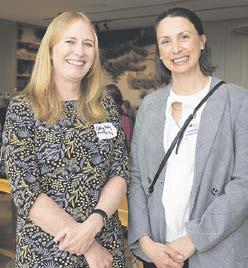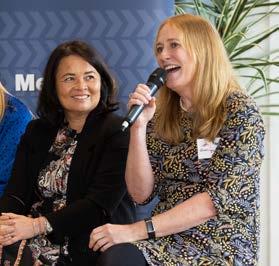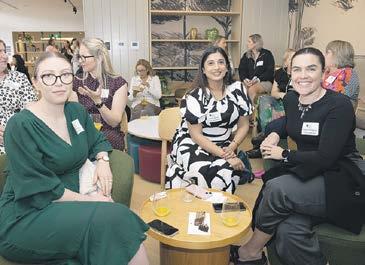BOLD VISION
BAY OF PLENTY
Our new columnist Todd Muller explores the region’s growth demands.
Page 2
HISTORIC SHIFT
From planner to chair, meet Bay of Plenty Regional Council’s Matemoana McDonald. Page 3
UP IN STYLE
Elevate your lifestyle at Elizabeth Towers in Tauranga. Page 4
ROTORUA GONGS
Rotorua features strongly in the Bay of Plenty’s royal investiture ceremonies. Page 13
Tomorrow’s leaders
From innovative peanut butter packaging to purpose-driven startups, Bay of Plenty students prove the region is a powerhouse of entrepreneurial talent. Senior writer Mary Anne Gill reports.
Young innovators have made their mark in the business world by sweeping top honours in two of the country’s most prestigious entrepreneurship competitions.
From university lecture halls to high school classrooms, their bold ideas and business savvy are turning heads - and setting the pace for the next generation of Bay of Plenty entrepreneurs.
They turned a personal insight into a purposeful business that adds value to the community.
- Pascale Hyboud-Peron, Stand Tall
The Mind over Markets team of Haydon Appleton (Mt Maunganui), Jan-Hendrik Hamann (Tauranga) and Hazel McAnulty (Whakatāne) won the Waikato Management School’s prestigious Case Competition at the University of Waikato.
The Case Competition - launched in 1996 and now in its 53rd year - is Waikato Management School’s ultimate test for its Bachelor of Business students. It is a hands-on real-world assignment that forms part of the Applied Business Challenge paper and now New Zealand’s longestrunning business competition.
The BOP students’ creative and commercially savvy pitch wowed the judges.
Their winning strategy for Pic’s Peanut Butter was for a defatted, low-calorie product in compostable packaging paired with a partnership with an Australian gym chain.
They also designed a clever square jar to help Pic’s stand out on supermarket shelves.
Pic’s, founded in Nelson in 2007,
has grown into New Zealand’s market leader in peanut butter, exporting to Australia and China.
A recent cash investment from Australia’s Scalzo Foods has positioned the company for international expansion.
Head judge Mark McCabe from PwC said the team impressed by “leaning into Pic’s brand story of sustainability” and backing up their ideas with clear commercial logic.
Pic's chief executive Aimee McCammon said she was amazed by the students' creativity, and the professional standard of their pitches.
The team competed against three other qualifying teams, each delivering a 10-minute presentation in front of a live audience at Waikato University’s The Pā.
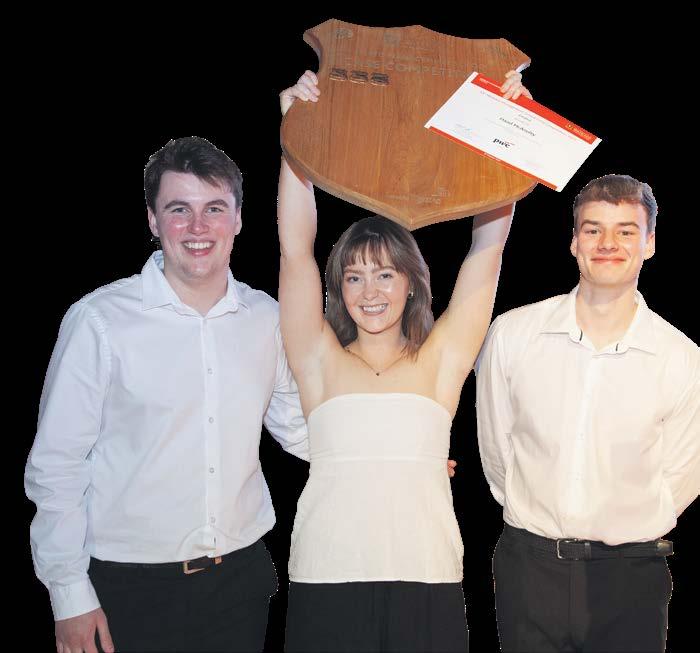
CONTINUED ON PAGE 5

Editor
David Porter dwp@davidporter.co.nz 021 884 858
Advertising Director
Janine Davy janine@goodlocal.nz 027 287 0005
Owner/Publisher
David Mackenzie david@goodlocal.nz 021 684 304
To Advertise sales@goodlocal.nz
News Tips editor@goodlocal.nz
Office/Accounts admin@goodlocal.nz
Website goodlocal.nz
Readers’ contributions of articles and letters are welcome. Publication of contributions are entirely at the discretion of editorial staff and may be edited. Contributions will only be considered for publication when accompanied by the author’s full name, residential address, and telephone number. Opinions expressed are not necessarily those of the publishers. Bay of Plenty Business News is published by Good Local Media Limited.
Also publishers of

By DAVID PORTER
Several years ago, I encouraged my teenage son to join me in delivering a sailing yacht from Malaysia to Hong Kong, where our family then lived.
The yacht was unusual being a recently built 52 foot wooden replica of a traditional Malaysian sailing craft. She was a two masted ketch and rigged as a junk, a quadrilateral sail type that seems to have originated in China. I found it to be a very practical and easy to use style of rigging.
Part of the reason for enlisting my son on the venture was that I was conscious my work commitments had taken me away from home too frequently and I welcomed the opportunity of spending uninterrupted time with him.
We worked our way from the Sebana Marina down a narrow Conradian stretch of water to the Malacca Straits, which form a border between Malaysia and Indonesia. We eventually turned north to Hong Kong.
All was going well until, little more than a week after we had set sail, my son who was






This newspaper is subject to NZ Media Council procedures. A complaint must first be directed in writing, within one month of publication, to the editor’s email address.
If not satisfied with the response, the complaint may be referred to the Media Council P O Box 10879, The Terrace, Wellington 6143. Or use the online complaint form at www.mediacouncil.org.nz
Please include copies of the article and all correspondence with the publication.



on morning watch, urgently called down to me to come on deck because the main sail was “collapsing”.
As indeed it was, the aluminium main mast having sheared off five or six feet above the deck leaving wreckage across the deck and into the water.
All I could do was to stand and curse at the devastation. Eventually, thanks in large part to my son’s contributions, we managed to salvage the sail and cut the wrecked mast top loose.
We found an old traditional triangular fore sail in a bow locker. We eventually managed to lash into place on the mast stump an aluminium dinghy hoist spar and erect a jury sail. Which all helped to steady the yacht’s motion, though it did very little for our speed.
Our voyage was eventually completed. However, our progress might best be described as glacial, except when it was disrupted by the occasional blast of wind or wave action.
REGIONAL VIEW
The long way home Growth demands bold vision
By TODD MULLER
One of the key projects underway is the negotiation between the region and the Government on terms of a Regional Deal and the establishment of a long term partnership framework.
There is still some water to go under the bridge as they say but one element is clear, we need a massive lift in housing to home the community of today let alone tomorrow.
Running hard alongside housing is roading infrastructure which is creaking under the weight of the Western Bay of Plenty emerging as an economic powerhouse for the country.
The Western Bay is expected to outperform the rest of the country in population growth - as it has in each of the first two decades of the 21st century. Since 2000 the population has increased 76% doubling the national average. If those average increases continue to 2050, New Zealand will have a population of 7.38 million and Tauranga a remarkable 283,000. This makes planning for roads, homes, commercial land and amenities for this region absolutely critical. It makes

the regional deal vital to assist the city to prepare for the growth.
Startling as those figures appear what I find remarkable is that we don’t know as a community whether those numbers are what we should be aiming for, whether they are too high or too low, because we do not have a formal national population strategy as a country.
We are also an economy under pressure. Net core crown debt has risen from $83 billion in June 2020, to $182 billion in June this year and forecast to rise to $238 billion in 2029.
However expectant we are for a material Crown/BoP regional deal, that alone will not close the infrastructure deficit we face.
But it’s not all doom and gloom. New Zealand is an attractive destination for people and capital.
We know our population will rise, and we are in an enviable position to be able to plan the form and speed of that rate. We need global capital to help fund our growth, it won’t happen by ourselves, so we should
On reflection, I think being forced to adjust to our reduced speed may have encouraged me to become a little more patient now when things don’t go as smoothly as anticipated.
And, despite what was in so many ways an epic experience, I find myself most frequently recalling one small incident from the voyage. As we were sailing slowly along under jury rig, hundreds of kilometres from land, we were surprised to notice that a stowaway had joined us.
A small bird – resembling a sparrow in size – suddenly appeared out of the sky and landed on deck. I had always been under the impression that sea birds were bigger creatures with vast wing spans, but this was very much the member of a small species which had been caught up in an offshore wind.
The bird stayed with us for a couple of days, during which he preened him or herself and took advantage of our stable platform. Then, refreshed, the bird vanished into the empty horizon.
consider how we could deal with both these pressing issues.
Imagine our part of the world in 25 years. The wealth, power and reach of China, India, Indonesia will be startling. So how should we engage with these economic superpowers. I argue against being passive and incrementally reactive.
As a starter for 10, what about the Western Bay pushing for 350,000 as part of a national plan to reach 10 million by 2050. What about the Western Bay corner of the golden triangle positioned as the most open to foreign capital, skills and global connections of all New Zealand. What about that incoming investment being tied to building infrastructure and environmental enhancement.
Just some thoughts to get you thinking, but I reckon our kids will come home for that.
• Todd Muller is a long term Tauranga resident, former MP and current chair of Priority One. All views expressed are his own.











Briefs…
Te Puke first
A new $96 million wastewater treatment plant will be built in Te Puke, using leading-edge technology that is a first for New Zealand. The treatment plant will replace the current facility which was built in 1987 and is no longer big enough to handle Te Puke’s growing population, or meet today’s environmental standards. The new plant will also be built to meet modern seismic and safety standards.
Fund opens
Applications are now open for the Western Bay of Plenty District Council CCTV Fund — with $50,000 available to help make shared spaces safer. The fund aims to help prevent crime and deter antisocial behaviour by adding to the growing network of cameras around the district. Since the fund’s introduction four years ago, it has supported the installation of 25 new cameras.
Sales up
Horticulture sales had strong growth year-on-year in the majority of the dominant horticulture regions in New Zealand for the period ending September 30, reaching 112 sales, up from 75. Regions that saw the most growth in sales were the Bay of Plenty region (up 121.7% to 51 sales) and Marlborough (up 7.7% to 14 sales). Kiwifruit orchards in the Bay of Plenty continued to anchor the sector.
High honour
Former chancellor of the University of Waikato Sir Anand Satyanand was awarded the university’s highest honour last month in recognition of a legacy of service. Sir Anand received an Honorary Doctorate for his significant contributions to the university and to the people of New Zealand. He served as chancellor from 2019 to June this year and helped set the university’s direction with strong leadership, commitment and courage.
Historic shift in leadership
From Bay of Plenty Regional Council planner to chair. Matemoana McDonald now leads a newly elected team into a transformative chapter for local governance. David Porter and Mary Anne Gill report.
Matemoana McDonald has been elected chair of the Toi Moana Bay of Plenty Regional Councilbecoming the first Māori and first woman to hold the role. Her appointment follows sweeping elections that ushered in nine new councillors, signalling a bold reset in leadership and direction for the 14-member council.
Newcomer Glenn Dougal of Tauranga will serve as deputy chair. The leadership refresh comes as nine new councillors join the 14-member team, with several former members – including chair Doug Leeder - stepping down or not returned in the ballot.
It represents a significant change, says long-serving councillor and former Tauranga mayor Stuart Crosby.
“We’ve met informally over the last few days and it’s a fantastic group and very talented, but it’s a big change,” he said.
McDonald - the Mauao Māori constituency councillor since 2017 - was the only nomination at the meeting in Whakatāne for the chair’s position which currently pays $164,175 a year.
The deputy, also the only councillor nominated, gets $84,540.
Before becoming a councillor, McDonald worked as a planner for the council and has 30 years local body experience in strategic planning, community development, cultural/ policy advisor, researchers and Māori land development.
“It’s not just about relationships, it’s all about relationships,” she says.
“My priority is getting the new team of councillors working together and connecting with the community for the best interests of the Bay of Plenty region.”
In addition to being a certified environmental commissioner and member of the Institute of Directors, McDonald also chairs a number of iwi groups.
Dougal, a business owner and trained meteorologist, has significant governance experience including being a director of Legacy Funerals which has returned $4 million to local charities.
“I bring a fresh perspective and I’m keen to make sure we have good governance and decision-making so we can look out for the best interests of our beautiful region.
“I understand the science that guides our decision making.

I’ve worked overseas with the BBC, European Space Agency, and Sony which gave me a global perspective I still draw on,” he said.
Leeder, who did not seek re-election, said it was a critical time for local government “and a good time to pass the baton to the next generation of leadership.”
Council chief executive Fiona McTavish said the new council included a great mix of people, who held a range of relevant skills and were representative of the region’s communities.
“I’m really excited that our new council is made up of people from a wide range of careers and experiences,” she said.
“Among our new leaders we have farmers, butchers, meteorologists, environmental experts, business owners and engineers – as well those who bring their previous local government experience to the table.”

Calls for reform

Former Tauranga mayor Stuart Crosby believes the entire local government engagements process needs to be reviewed.
Back for his fourth term on Bay of Plenty Regional Council after 12 years as Tauranga mayor, Crosby, 69, is well placed to comment. He also served as president of Local Government New Zealand for three years from August 2020.
“The current system is not serving New Zealand well,” he says.
“But what I would oppose is some ad hoc [new system] being imposed.
“We need a [revised] version after a formal inquiry with some recommendations that engage people.
“We need a complete overview of the structure moving forward.
“The worst thing that could happen is a kneejerk reaction from whoever is the government of the day,” he says.
Crosby says central government relies on local councils to deliver many of its hopes, dreams and ambitions — and if local government is broken, as he believes it is, frustration is inevitable.
“The key in my view is to get that balance right between local democracy and local voice. That’s the balance you want to achieve and I believe we can achieve it.”
He also stressed the importance of ensuring regional experience is heard and considered.
“If the system of relationships within the organisation and in groups that comment to the government, iwi and others, is not cohesive, then you have a problem.”
- David Porter

MOVEINBYCHRISTMAS!

Brand-new apartments and garden villas selling now!
From the beautifully appointed luxury apartments and garden villas, to the unrivalled views, Elizabeth Towers sets a new benchmark in inspired, elevated living. Enjoy exceptional, resort-style amenities including a full-sized swimming pool, spa, gym and residents’ lounge set amongst extensive, landscaped gardens with world-class dining and retail on your doorstep.
Secure your elevated lifestyle – enquire now.


Sherryl Todd
+64 21 222 6308 sherryl.todd@bayleys.co.nz
Ashlea Pead
+64 21 857 705 ashlea.pead@bayleys.co.nz
Tomorrow’s leaders
Previous companies involved in the Case Competition include Zealong Tea, Zuru Toys, Annah Stretton Fashion, Yealands Wine Group, Ozone Coffee, and Tainui Group Holdings Ltd.
They competed against three other qualifying teams each giving a 10-minute presentation in front of a live audience at Waikato University’s The Pā. All three students were educated in the Bay of Plenty.
• Hazel McAnulty, 20, attended St Joseph’s Primary and Whakatāne High School. She is completing a Bachelor of Social Science, double majoring in Strategic Management and Psychology. After a holiday overseas, she plans to return to New Zealand and “mass apply” for strategy, policy, and advisory roles.
• Haydon Appleton, 21, went to Omanu Primary and Bethlehem College. He has completed a Bachelor of Business majoring in Economics and Strategic Management and hopes to secure a graduate role in Tauranga.
• Jan-Hendrik Hamann, 20, originally from Waiuku, attended Sandspit Road School and Tauranga Boys’ College. He has completed a Bachelor of Business with a double major in Economics and Strategic Management and will study for a Graduate Certificate over summer before job hunting in the Bay.
They are not the only recent winners from the bay. Former Tauranga Girls’ High School student Alysha Gill, 21, was part of last year’s winning Aotearoa Advisory
team. That team developed a mobile app for Ozone Coffee and proposed buying smaller UK roasters. Alysha has since secured an internship with Holland Beckett Law Firm in Tauranga.
Further proof of the region’s entrepreneurial strength came from Rotorua and Tauranga, where Taupō-nui-a-Tia College and Aquinas College won the regional Young Enterprise Scheme (YES) finals.
Both schools will represent Taupō and Tauranga respectively at the Lion Foundation YES National Final in Wellington next month, competing against 21 other regional winners. With over $20,000 in prizes, scholarships, and national recognition at stake, the opportunity is immense.
The two regional finals brought together more than 100 students, teachers, business mentors, and community leaders. YES offers students hands-on experience in entrepreneurship. Participants learn about product development, marketing, financials, and business operations, gaining skills that prepare them for life beyond school.
Stand Tall delivers the YES programme in Tauranga, Bay of Plenty, Rotorua, and Taupō.
In Tauranga, the Aquinas College team Buzz ‘n Buff - Cullen Anderson, Noah Ball and Sahara Hutchessondeveloped a natural beeswax-based shoe polish designed especially for cadets.
Cullen’s own experience as an Air Force cadet struggling to find a
polish that was affordable, effective and environmentally friendly sparked the idea.
Their solution stood out to judges for its strong sustainability values and market-ready design. Buzz ’n Buff uses locally sourced ingredients and is ethically produced. It sells for $10 - a fraction of the price of imported alternatives - and has already found a loyal following among cadets in the Air Force, Army and Navy.
Stand Tall general manager Pascale Hyboud-Peron said Buzz ’n Buff captured what YES is all about.
“They turned a personal insight into a purposeful business that adds value to the community.”
The Rotorua-Taupō winner was Daisy Hoe, a solo entrepreneur from Taupō-nui-a-Tia College, who won with her Go Able business concept.
She created a user-generated map of accessible places for wheelchair users, designed to rate and review their accessibility.
Go Able impressed the judges with its data-driven validation and Daisy’s strong commitment to making a difference for her community. She was recognised for her innovative approach to making outdoor adventures accessible to everyone.
Together, these young entrepreneurs are not only building businesses – they are building a future.
Their success is a testament to the power of creativity, community, and the belief that great ideas can come from anywhere.










































Cutting rates, raising risks
By PETER NICHOLL
The Reserve Bank reduced its Official Cash Rate last month by 50 basis points to 2.5 per cent.
The bank was widely congratulated and many commentators thought they should reduce the Official Cash Rate by another 25 basic points at their next Official Cash Rate meeting later this month.
I think the Reserve Bank’s approach is risky for two reasons. First, inflation in New Zealand is not yet under control. The September Consumer Price Index number came out recently. It was 3 per cent, right at the top of the Reserve Bank’s target range. The Reserve Bank has eased monetary policy significantly even though they predicted, correctly, that inflation would rise.
That was their first mistake. They said that they expected this increase in the Consumer Price Index ‘to be transitory’ - that the Consumer Price Index would come back within their target range quickly.
They have said this before – and got it wrong.
I think this will be their second mistake. Food prices are still rising by around five per cent per a year, power prices, rates and insurance are all still rising by even more. There are a number of large wage claims still unsettled. Our exchange rate is continuing to fall, which adds to import prices.
My second reason is that the Reserve Bank is taking a much more benign view of global inflation risks than most other central banks. In December last year, the Reserve Bank’s Official Cash Rate was 4.25 per cent, which was equal to the policy interest rate in the United States and similar to those in Australia and the United Kingdom. Since then, the
Reserve Bank has reduced its Official Cash Rate by 1.75 per cent. Australia and the UK have reduced their’s by 0.75 per cent and the US by only 0.25 per cent.
Yet New Zealand’s inflation rate is currently higher than in the US or Australia. With interest rates in New Zealand now being significantly below those in the US, Australia and the UK, our exchange rate is likely to keep on falling.
The Reserve Bank pre-announces the dates on which they will take their Official Cash Rate decisions. They have announced the next nine dates, all the way out to February 17, 2027. The economy doesn’t move in a smooth fashion and when it is the right time for the Reserve Bank to act can’t be determined in advance.
The timing of the next Official Cash Rate decision on November 26 illustrates this. Five days later Anna Bremen will become the new governor.
The gap between Official Cash Rate decisions is usually six to eight weeks. But this summer the gap will be 12 weeks – all the way to February 18, 2026. The Reserve Bank has already taken a risk by significantly lowering its Official Cash Rate at the same time as inflation rose to the top of the target range.
If the bank lowers the Official Cash Rate further this month, as most economic commentators are proposing they should do, the new governor could have a difficult start to her tenure.
• Peter Nicholl was formerly Reserve Bank of New Zealand deputy governor, World Bank Board executive director and Centre Bank of Bosnia and Herzegovina governor. He is now retired.

Fixing Holidays Act confusion
By ALAN M c DONALD
The government is on the brink of fixing one of our most frustrating and confusing pieces of employment law.
For years, the Holidays Act 2003 has been recognised as a minefield of complexity, legal risk and unintended cost for both employers and employees.
It has confused the most diligent businesses with complex calculations and compliance headaches, while leaving workers unsure of what they were entitled to or when.
In late September, we saw the shape this new legislation will take when Workplace Relations and Safety Minister Brooke van Velden announced the proposed reforms at our EMA headquarters.
These will provide the foundation for the first draft of legislation, which will likely be released for public consultation and submissions early in the new year.
The new framework looks to deliver a system that is simpler, fairer and far easier to navigate for all types of work.
At the heart of the reform is the shift to an hours-based accrual system for annual and sick leave. Rather than waiting six or 12 months before leave starts to build up, entitlements now begin on day one, accumulating with every hour worked.
Leave can now be taken in part-days or even part-hours, meaning workers can take time off when they truly need it without burning a full day’s entitlement. That’s a win for fairness.
The new leave compensation payment of 12.5% for casual and additional hours worked replaces the previous 8% “pay-as-
you-go” approach.
Workers see an immediate uplift in pay for each hour worked beyond their standard hours while employers gain a predictable, transparent cost structure.
Even the long-criticised “parental leave override”, which often penalised parents returning from leave with reduced holiday pay, is gone. Under the new proposals, parents will be paid their normal rate for annual leave after returning to work. That’s a family-friendly outcome to support.
Another long-overdue fix is the clear test for determining whether a public holiday is an “otherwise working day”. Instead of a subjective, case-by-case debate, there will be a simple rule: if an employee has worked at least half of those days in recent weeks, the holiday counts.
Every reform comes with trade-offs. Some part-time employees will see a reduction in sick leave compared with the current flat allocation. And employers will face transition costs as payroll systems and employment agreements are updated. But these are short-term challenges for a longterm gain: a leave system that works.
For the EMA, this reform is the culmination of years of advocacy and we’ve been working closely with the Ministry of Business, Innovation and Employment and the minister to present the views of the business community.
• Alan McDonald is Head of Advocacy for the Employers and Manufacturers Association (EMA). Brooke van Velden will be in Tauranga on November 13 to explain the changes to members.














































































Harbouring global connections
Two back-to-back ship arrivals marked the start of the Tauranga cruise season last month, as the region prepares to welcome up to 230,000 passengers and crew over the next seven months.
Celebrity Edge, carrying up to 4300 passengers and crew, was the first to glide into the city’s harbour followed by Celebrity Solstice.
Both ships were on 20-day voyages from Honolulu to Sydney, carrying mainly American and Australian
passengers. French Polynesia was their last port of call before Tauranga.
The Bay of Plenty’s tourism sector is excited about the steady influx of international visitors, as other parts of the country anticipate a noticeable downturn in cruise passenger numbers this season.
Tauranga has always been one of New Zealand’s most popular cruise ship stops.
Two ships that have booked to visit the country for the first time this
season make the Port of Tauranga their first or only New Zealand stop. Anthem of the Seas, owned by Royal Caribbean Cruises, docked in Tauranga Harbour on Labour Day (27 October), carrying up to 4180 passengers and 1500 crew. It was the ship’s only New Zealand port of call, with its passengers starting their voyage in Vancouver and finishing in Sydney.
Discovery Princess, one of the newest ships in the Princess Cruises fleet,


will also make Tauranga its first port of call next month during its inaugural visit to the country.
Tourism Bay of Plenty has been busy preparing for the start of the cruise season.
Head of destination management, Mary Tolley, says 82 ships are due to dock in Tauranga before early May.
“We’ve been working hard in the background — alongside our key partners and stakeholders, New Zealand Cruise Association, Port of Tauranga, Tauranga
City Council, Western Bay of Plenty District Council, Bay of Plenty Regional Council, Downtown Tauranga, Mount Mainstreet, cruise lines, and local tour operators — to ensure a smooth season ahead.
“We’re operating a popup isite visitor centre and tour operator station inside the port gates, supported by our fabulous staff and volunteer ambassadors.
“Cruise ship visits are a much-loved and vital part of our city’s communities and economy.”
The ships, and the people they bring, contributed an estimated $111.8 million to the Bay of Plenty region during the 2023/2024 season.
“Many employees and businesses rely on this revenue, so we’re all saying, ‘bring it on!’ as we kick off this next cruise season.”
"We’ll also assist with traffic management outside the gates on the busiest ship days,” Mary says.



Energy deal struck
Infratil Limited (Infratil) has announced its agreement to buy TECT Holdings’ 4.92 percent shareholding in Contact Energy Limited (Contact).
The purchase price of $437.7 million, or $8.95 per share, will be funded through a combination of $218.8 million in existing debt capacity and the issuance of $218.8 million of new Infratil shares to TECT at $12.43 per share, the relevant NZX closing price.
TECT was formerly known as the Tauranga Energy Consumer Trust.
On completion, Infratil’s shareholding in Contact will rise to 14.3 percent, up from 9.4 percent following the recent merger of Contact and Manawa Energy. Infratil had earlier completed the sale of its 51 percent stake in Manawa Energy to Contact in July 2025, in return for approximately NZ$186 million in
cash and its current shareholding in Contact.
The company says the acquisition reinforces Infratil’s strategy to invest in high-quality assets in strong market environments.
Infratil chief executive Jason Boyes says in a statement that the transaction is a winwin for both parties.
“TECT’s decision to diversify created a natural opportunity for us to increase our investment in Contact. Partfunding with new shares efficiently preserves our flexibility for future growth, while increasing ownership of a strong cashflow-generating business.”
Boyes says the company has a deep understanding of the sector through its ownership of Manawa Energy and is confident in the opportunities created by its merger with Contact.

Wayne Werder
“We look forward to supporting Contact’s leadership as they drive the combined business forward, and we appreciate TECT’s decision to remain invested in us through Infratil shares,” he says.
TECT’s chief executive, Wayne Werder, says: “We’ve invested alongside Infratil in Trustpower and Manawa for more than 30 years and therefore have a long-standing history of working together.”
Werder says TECT knows the Infratil team and their track record well and is delighted to continue this relationship by becoming an Infratil shareholder and will benefit from diversification through their broader portfolio.
TECT drives top returns
The Tauranga energy trust reports strong returns amid strategic diversification, writes David Porter
Tauranga-based charitable trust
TECT has reported a strong year-on-year performance, with chief executive Wayne Werder attributing the gains to strategic decisions made several years ago.
TECT, originally known as the Tauranga Energy Consumer Trust, was renamed TECT Consumer Trust following a restructure designed to ensure it could continue providing annual rebates to beneficiaries.
Werder told The News that this year’s results were up 40 per cent, year on year.
“We made a commitment to growth and it’s really paid dividends,” he said.
“As a charitable trust it’s good for the longer term that we can take on a bit of a liquidity.”
Originally, as the energy consumer trust, TECT held only company shares. That position has since been reduced, with the Trust committing in
recent years to a more diversified investment strategy.
The company has just reached the 10-year anniversary of its commitment to a Diversified Portfolio.
Reflecting the diversified approach, TECTC has announced the sale of 20 million of its shares in Trustpower. This reduces TECT’s holding from 33.2 per cent to 26.8 per cent of shares in the company.
The shares have been sold at a price of $7.74 per share, totalling gross proceeds of $154,800,000.
The sale of 20 million shares – which represents 19.3 per cent of TECT’s shareholding in Trustpower, and 6.4 per cent of Trustpower’s shares on issue – ensures TECT retains the same degree of influence around the Trustpower board table, the company says.
TECT chair Bill Holland says the decision to
diversify follows a robust decision- making process driven by a need for financial prudence and follows the Trust’s Share Ownership Review. The review, and subsequent consumer consultation, was originally held in 2013 when it was resolved that trustees had the right to sell 6.55 per cent of the shareholding in Trustpower if they considered it in the best interests of TECT and its consumers.
“It is a sound business decision in line with our strategic priority of ensuring prudent management of the trust’s investment portfolio,” said Holland.
“TECT trustees retain their confidence in Trustpower. Trustpower continues to have excellent prospects and for this reason we remain committed to the company long term and have ensured our influence is retained. Our ownership in Trustpower still accounts for more

than 80 per cent of trust assets.”
The restructuring of assets is not anticipated to adversely affect TECT’s grants programme or annual pay-out to its consumers, with TECT committed to maximising the investment returns for the benefit of consumers.
“We will continue to be driven by a desire to manage our investments in a manner consistent with our trust deed and values so that the funding available to benefit consumers, and future generations of consumers, will be maximised,” said Holland.
Demand for the Trustpower shares was strong, with allocations being made to a broad range of NZ and Australian institutions and retail investors. Following the sell down TECT remains a 26.8 per cent shareholder of Trustpower. TECT confirmed it has no intention of selling any further Trustpower shares in the foreseeable future.
Sponsored Content
A smarter, value-driven approach to project delivery
> By MAHÉ DRYSDALE, Mayor of Tauranga
Tauranga City Council has entered a new chapter in its capital project programme delivery, with a primary focus on providing better value-for-money and positive outcomes for the community.
The new approach is exemplified by the reset of the Memorial Park Aquatic Centre project. A budget of $123.4 million had been set aside for a new aquatic centre at Memorial Park in Tauranga as part of the Commission-led 2024-34 Longterm Plan. Around that time, the old Warehouse building at 483 Cameron Road was purchased to convert to the new four indoor court facility, Haumaru, because early investigations indicated that the Queen Elizabeth Youth Centre (QEYC) and Memorial Hall would need to be demolished.
The then-newly-elected Council paused the aquatic centre project in October last year while more information and community feedback was sought. Following that process, Council elected members have
now confirmed a new direction that will see a redesigned aquatic centre built on the site of the existing Memorial Pool, with the QEYC and Memorial Hall kept operational until 2041.
I have to say that elected members were disappointed by the $4.7 million that had been spent to date on the aquatic centre (covering aspects such as a business case analysis, concept and developed designs, engineering and contractor costs and geothermal and geotechnical investigations, along with legal and staff costs), before we paused the project. Having looked at alternative options, I’m confident that our new direction will deliver this much-needed community facility for tens of millions of dollars less than had been budgeted, which is a win for everybody because it will allow us to spread investment further across our communities.
The money spent so far is considerable, but it’s expected that work associated with foundation design, selection of pool tanks, mechanical and electrical design will be applicable to the new facility. So we’re not starting from
scratch - we’re building on what’s already been done, doing it smarter and achieving a significant saving overall.
For example, by shifting back to the old pool site and keeping the QEYC and Memorial Hall open, we’ve saved $2.4 million in demolition costs. And by retaining three much-needed indoor courts for another 16 years, we’ve avoided future replacement costs, and those savings are a direct result of our change in approach.
A Project Steering Group, including Councillors, will guide the next stage of design development for the aquatic centre. The revised concept will prioritise value for money and functionality, considering a mix of indoor and outdoor facilities to support lane swimming, aquatic sports, learn-to-swim programmes, hydrotherapy, and recreational play.
The feedback we’ve heard also indicates that Tauranga needs a 50-metre pool for competitive sports, but Memorial Park is not an ideal location. If we can save money here, delivering a 50-metre pool elsewhere can be sped up and other priority projects will become affordable sooner.
While acknowledging past concerns about Council spending, we can confirm that this Council is focused on delivering projects with greater transparency, accountability and cost-efficiency. We’re confident that the changes we’re making will bring improved financial rigour and more discipline to our project management processes, ensuring that ratepayers’ money is well-spent, where it’s needed most. There are some projects we won’t be able to influence, due to the stage in the delivery cycle they’re in, but we will continue to look for efficiencies wherever we can.
All this will require some tough calls, but we make no apology for that. It’s our job as elected members to deliver value for our people and that may mean that some projects are delayed, or even cancelled, if they won’t deliver value for money.
The new direction for the Aquatic Centre, and other
projects in the pipeline, reflects our commitment to stopping unnecessary spending and focusing on smart, cost-efficient and community-focused solutions.
Note: In keeping with the Council’s commitment to transparency, a breakdown of the Aquatic Centre costs has been made available on Tauranga City Council’s website.



Apprentice builder nails second place
Waihī Beach builder Caleb Stuart seized second place in the national Master Builders Apprentice of the Year competition in Auckland last month.
Josh Gullery from Waikato claimed the top spot, edging out six other finalists from across New Zealand. Jade Murray from the Central North Island region finished third.
Earlier this year, Stuart won the Bay of Plenty & Central Plateau regional title. He works for A Knight Design & Build and trains through Building and Construction Industry Training Organisation (BCITO), which oversees building apprenticeships nationwide.
Judges at the Carters Building Supplies-sponsored finals praised Stuart’s confidence, technical skill, precision and professionalism. A keen skateboarder and capable all-
rounder, he excelled in both the practical and interview challenges.
“His thoughtful planning and deep understanding shone through, revealing a builder who thrives on complexity and takes pride in his craft,” judges said.
The competition tested technical ability, knowledge of the Building Code, and project management skills. For the practical challenge, apprentices built wooden trainsmeasuring about three metres by 1.5 metres - which were donated to Auckland early childhood centres. Each build incorporated design input and safety requirements from the centres.
Carters’ chief executive Mike Guy commended the talent on display.“It’s inspiring to see apprentices nationwide showcase their dedication and skill - these are the future leaders of our trade,” he said. – Mary Anne Gill

> FAIRNESS AFTER DEATH:
Denyer secures another term
Western Bay mayor James Denyer has been re-elected with a stronger mandate and a renewed focus on regional collaboration, housing, and transport, reports David Porter.
Western Bay mayor James Denyer learned of his re-election while speeding across the harbour on a Coastguard vessel - a fitting start to a second term focused on momentum, alignment, and delivery.
Denyer won with an increased majority and has appointed Margaret Murray-Benge as his deputy.
“I’m very pleased to have been re-elected,” he told The News. “The margin of victory was larger than I expected - there were some strong candidates in the mix.”
Darlene Dinsdale was elected to represent the Waka Kai Uru Māori Ward, though this will be her final term. In a binding referendum held alongside the election, residents voted to remove the ward from 2028.
One of the new council’s first tasks is hiring a permanent chief executive for the Western Bay.
“We have an interim at the moment, so the new hiring is being progressed now.”
which includes Tauranga and the Bay of Plenty, aims to streamline development processes across local and national agencies.
“We need to finalise the regional deal either later this year or earlier next year,” he says.
It was important to create longterm alignment otherwise local governments could come and go without achieving what was needed.
Denyer says he is looking forward to putting together a team for the new council.
“There are new councillors there and I look forward to working with them to pull us together in a cohesive team. That’s what we’re

doing now.”
He identified transport, housing, and the cost of living as his top priorities for the term ahead. He believes the regional deal could help unlock better infrastructure and housing opportunities.
Spending smartly and prudent financial management would help with the cost of living, he said.
As for the moment he learned of his win, Denyer was aboard the Waihī Beach Coastguard’s new vessel during its maiden voyage. “We were going full borel in the harbour when the call came through - I could barely hear it,” he said.
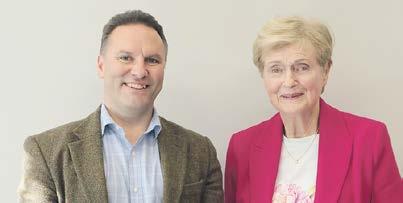
A top priority for the mayor is progressing the regional memorandum of understanding (MOU) recently announced by the government. The agreement, Western
Sponsored Content
Claims against estates under the Family Protection Act 1955
The starting point in New Zealand is that individuals have testamentary freedom to dispose of their assets under their will as they choose, however our laws consider that they also have a moral obligation to make provision for those people who have depended on them during their lifetime.
The Family Protection Act 1955 (“FPA”) seeks to address situations where a will maker is deemed to have not made adequate provision for the proper maintenance and support of certain family members.
People entitled to bring a claim under the FPA include:
• Spouses or civil union partners.
• De facto partners (provided they were living in a de facto relationship with the will maker at the time of the will maker’s death).
• Children and grandchildren.
• Stepchildren who were financially supported by the will maker at the date of death.
• Parents ( if there is no surviving spouse, de facto partner, or child of the will maker).
A claim against an estate
must be filed in either the Family Court or the High Court within 12 months from the date probate or letters of administration are granted.
The Courts have a wide discretion when deciding if a will maker has breached their moral obligation to a claimant and will consider a number of factors including but not limited to:
• The financial position of the claimant.
• The value of the estate.
• The strength of the relationship the claimant had with the will maker.
If a breach of moral duty is found to exist, the Courts have the authority to make an award to the claimant to remedy the breach but will not go so far as to rewrite a will to make it ‘fair’.
Any intervention by the court
> It is important to note that the FPA applies only to assets that fall into the will maker’s estate. Any assets that have been transferred to a trust or gifted during the will maker’s lifetime are not within the scope of the FPA.
will only be to the extent necessary to remedy the moral breach. It is important to note that the FPA applies only to assets that fall into the will maker’s estate. Any assets that have been transferred to a trust or gifted during the will maker’s lifetime are not within
the scope of the FPA.
Family structures are becoming increasingly more complex and if individuals wish to avoid disputes arising after their death, then careful consideration should be given to estate planning.
To reduce the risk of successful claims being made after death a will maker should review their will regularly to ensure it is up to date and reflects their current circumstances.
If a will maker wishes to leave a significant family member out of their will, then clearly documenting their reasons and intentions is important to assist in the defence of any claim made against the estate under the FPA. Whether you need advice on safeguarding your assets after your death or on your entitlements under an estate the team

LAW BY NIAMH HOOPER & KATE SULLIVAN
at Tompkins Wake has extensive expert experience in asset planning and resolving disputes against estates.
Kate Sullivan is a Partner at Tompkins Wake, Rotorua. She can be reached on 07 838 6054, or kate.sullivan@tompkinswake.co.nz
Niamh Hooper is a Solicitor at Tompkins Wake, Tauranga. She can be reached on 07 578 5033, or niamh.hooper@tompkinswake.co.nz
Biorefinery opens
The world’s first commercial seaweed biorefinery opened in Paeroa last month. AgriSea will produce up to 1600kg of eco-friendly nanocullulose hydrogel a week which can be used across the medical, agricultural and cosmetic industries, among others – e.g. for advanced wound dressings and drug delivery, better seedling survival and as a renewable cream base. The Bioeconomy Science Institute has a strong partnership with AgriSea providing the technical and scientific expertise to help them make this a reality. The idea was initially born following an informal meeting between AgriSea owners Clare and Tane Bradley and two of the institute’s scientists. Photo: Supplied.

THE AGE OF REASON Trump puts pressure on Ukraine

By RICHARD STEELE
I hear that Donald Trump has told the Ukrainian president to accept the Russians taking what they want from his country, or risk being annihilated by them. What an awful choice to have to make, to give up whatever your violent aggressor wants, and he will want heaps, or have him take the lot.
Either way you lose, so taking the lesser of those evils is the only way out. Or is it? Russia will still eventually want it all, whatever you decide now, so it again becomes an impossible situation to win from.
My question though, through all this, is, where are the European neighbours in all this bullying? From where I sit, albeit a fair way from the battle front, it seems as though the Russians won’t stop there. If they are allowed to get away with this one, where or when will they stop?
And surely with the combined resources of the European military might, virtually over the fence, could show the Russian bully a thing or two. I know they are already helping, but thus far that help hasn’t done much to slow the aggressor.
Or is there more to this terrible war than anyone realises? I’m
> WHY IT’S TIME TO UPGRADE
Windows 10 has reached the end of the runway
After ten years in operation, Microsoft officially ended support for Windows 10 on 14 October 2025. This is more than just a technical milestone –it’s a turning point for businesses and individuals alike.
While Windows 10 will continue to run on existing machines, it will no longer receive security updates or bug fixes. That means every day you continue to use it, your systems become more vulnerable.
From a cybersecurity standpoint, this is the biggest concern. Without ongoing patching, any newly discovered vulnerabilities are left exposed, creating an open door for malware, ransomware, and phishing attacks. For businesses, this could result in serious data breaches, compliance issues, reputational damage, and costly downtime.
Microsoft does offer Extended Security Updates (ESUs) for
> Windows 10 will continue to run on existing machines, it will no longer receive security updates or bug fixes. That means every day you continue to use it, your systems become more vulnerable.
enterprise users, but this is only a short-term safety net – and it comes at a cost. The ESU programme is designed to give larger organisations time to transition, not to delay indefinitely.
For most users, the most secure and sensible step is to upgrade to Windows 11. Windows 11 introduces built-in security features that are far more robust than its predeces-

TECH TALK
BY TIM TAYLOR
sor. Hardware requirements such as TPM 2.0 and Secure Boot are now mandatory, helping to prevent firmware attacks and unauthorised access at a much deeper level.
Features like Windows Hello and BitLocker improve identity protection and data encryption – both essential in today’s threat landscape.
But the shift isn’t only about security. Windows 11 offers a modern, streamlined user experience that’s been redesigned for productivity. A cleaner interface,
no student of history - do the Russians have a case, or is this just a continuation of the colonisation that’s been going on ever since man came down from the trees, and that’s has plagued weaker nations since time began?
And have we as people of the world learned nothing from the mistakes of the past? It would appear not.
Equally the great so-called peacemaker who claims to have ended 10 wars, is out of his depth on this one. He appears to be losing the peace in his own country, so why would anybody listen to him in any case?
If the Europeans cannot get together and sort out Putin, it seems as though the poor Ukrainian people are buggered.
And that’s a tragedy.
I know the Donald has his supporters, millions of republicans think he is just the bees’ knees, but I just cannot see why, what planet are they all on?
I’m still convinced that we will see civil war in the great United States soon, and all his so called peace-making will be in vain, and rather than win the respect of the world, he will become an even bigger laughing stock.
I hope I’m wrong.
Briefs…
Towers open
Elizabeth Towers, a mixed-use residential and commercial complex in Tauranga, has gone on sale with occupation available before Christmas. It offers luxury apartments, garden villas, and penthouse residences and features a “Sky Garden” with a pool, spa, and gym, along with dining, lifestyle amenities, and a concierge service.
IP book
An unconventional approach has led to a locally written book rapidly achieving international acclaim on what could be considered a dry topic - Intellectual Property. The book by IP strategist Kate Wilson has already attracted international recognition, including endorsements from leading business figures. Its appeal lies in taking what could be a daunting subject and presenting it in a way that is practical, engaging and even entertaining.

centred Start menu, improved animations, and features like Snap Layouts, Focus Assist, and Virtual Desktops make it easier to manage tasks, reduce distractions, and boost efficiency.
Windows 11 is also designed to support the latest hardware innovations, ensuring better performance, faster boot times, improved battery life, and smarter resource use.
For teams working in hybrid or remote environments, the built-in Microsoft Teams integration makes collaboration simpler and more accessible.
Whether you run a professional services firm, a busy retail operation, or a growing aviation business, staying on an unsup-
ported platform introduces avoidable risk.
Upgrading ensures not just compatibility, but continuity.
At Aviation IT, we help clients navigate upgrades with minimal disruption, ensuring systems are properly assessed, backed up, and transitioned with care.
If your hardware is compatible and your business relies on security, now is the time to act. Soaring to new heights in I.T. Experience better I.T.
Tim Taylor is the Managing Director at Aviation IT, based in the Bay of Plenty. He can be contacted on 07 777 0025 or 021 222 6455, tim@aviationitservices.co.nz www.aviationit.co.nz
Contractors celebrate excellence awards
Higgins’ work on the entrance interchange for Rangiuru Business Park near Te Puke earned the company top honours at the Civil Contractors Bay of Plenty Excellence Awards last month, securing both the Supreme Award and the award for projects valued over $5 million.
Held at Classic Flyers in Tauranga, the awards evening brought together more than 150 guests for a formal dinner celebrating the expertise, commitment, and achievements of the region’s leading contractors over the past year.
The new industrial park aims to unlock economic growth for the Bay of Plenty by providing a high-quality location, modern facilities and easy road and rail links to the Port of Tauranga.
Judges Nic Johansson and Allan McFall congratulated Higgins for delivering a “transformative project” while contending with major weather events and engineering challenges.
“The scale demanded strong coordination skills, particularly with the number of
trades needed for the job,” Johansson said. “Higgins delivered the project with a clear focus on safety performance, community engagement and cultural sensitivity.”
Brian Perry Civil won the award for projects valued between $1 million and $5 million for a well-executed repair to the Brett Heaven underslip on State Highway 25 in Coromandel.
The judges noted that the project was achieved below budget and ahead of schedule, congratulating Brian Perry Civil for the “innovative methodologies” and “smart redesigns, efficient planning, tight cost control and excellent communication” used throughout the slip repair.
The third project award for the year, awarded for works valued at up to $1 million went to Mount Maunganui company Bridge it NZ for its work on the Tukemokihi Bridge, located on Tukemokihi Station, between Gisborne and Wairoa.
The Mount Maunganui business took on the project after the previous bridge
collapsed following a storm in 2022, with team members travelling to Hawke’s Bay to construct a challenging single-span bridge to restore access across a 50-metre ravine.
A remote and extremely difficult topography made conventional construction methods impossible,” judge Johansson said.
“Meticulous planning and a collaborative approach between bridge designers and builders came up with a unique launching method for installing the bridge –a brilliant project, very well executed.”
The awards also recognised outstanding individuals making their mark in Bay of Plenty’s construction industry.
Dara Patrick from Brian Perry Civil won the Emerging Leader award.
People award category judges Melissa Porteous and Christi De La Porte lauded his dedication to completing a Bachelor of Engineering degree while working full time, his work on major projects such as the Omokoroa Water Treatment Plant, and his leadership, mentoring and calmness under
pressure. Hollie Atarau from Waiotahi Construction was highly commended in the same category.
The Outstanding Individual award went to Angela McNeill from Downer.
The judges recognised her 25 years in the industry, technical expertise, advocacy championing women and Māori in construction, and volunteer service with Tauranga’s homeless community.
Mark Seymour from Brian Perry Civil was highly commended in the Outstanding Individual category.
CCNZ Bay of Plenty
Vice-president Mike Speed congratulated all those recognised at the awards for their contribution Bay of Plenty and New Zealand infrastructure.
“The people and companies honoured tonight are deserving of thunderous applause. The winning projects have been incredibly well executed, helping to connect communities and grow the economy, while the individuals honoured have done themselves proud and made an incredibly positive impact on all those around them.”
Inland Revenue cracks down on tax debt
Have you ever wondered what happens if you don’t pay your taxes on time? You don’t have to look far in the media these days to find articles on the level of tax debt and what Inland Revenue is doing about it.
Since COVID 19 the level of tax debt has more than doubled from $4.3m in June 2020 to $9.3m in March 2025. The initial rise in debt levels can be attributed to Inland Revenue’s be kind approach during COVID when outstanding debt was allowed to build up and was only lightly policed, and is compounded by the current economic climate.
Over half of the debt is GST and PAYE debt. These amounts are actually tax that has been collected by businesses on behalf of the Government and employees, and Inland Revenue takes
a particularly dim view of taxpayers that don’t pay these taxes on time.
So what is Inland Revenue doing about this? Well if you have outstanding tax debt, you can expect the personal touch. Since early October, compliance officers have been calling taxpayers with more than $1,000 of tax debt which is at least 6 months old. If they cannot get hold of you by phone, you should expect an in person visit to encourage you to pay up or set up a payment instalment arrangement. You could also be contacted by Baycorp, who started a pilot programme with Inland Revenue earlier this year to increase the odds of making contact with defaulting taxpayers. If these actions still don’t get the tax paid, there are other avenues available to Inland Revenue. They







ANDREA SCATCHARD
have the power to request deductions from the bank accounts of taxpayers, and have been using this effectively. Since June this year, more than 16,000 deduction notices have been issued, which is 25% more than in the whole of the year before, and more than $17m has been collected this way. The amounts deducted can be quite high and could have a real impact on someone’s cashflow which reinforces the need to engage early with Inland Revenue if you find yourself behind on paying

your tax debt. As a last resort, Inland Revenue does not shy away from liquidating companies if it is unable to recover the debt. The year to June 2025 saw 1,701 liquidations instigated by Inland Revenue, a 31% increase from the year before. While in many cases the tax is unlikely to be recovered in a liquidation, even where tax debt ranks higher than other creditors, forcing liquidation will stop the debt from increasing both for all creditors.
So the moral of the story is that if you don’t pay your taxes in time and let things get out of hand, you will be in line for some unwanted attention from Inland Revenue. Your accountant can help you navigate the process with Inland Revenue to give the best possible outcome.
Brett bags big prize
Eastern Bay of Plenty kiwifruit grower and harvest contractor
Brett Wotton has won the 2025 Kiwifruit Innovation Award for his work to support lifting fruit quality across the industry.
The Ōpōtiki stalwart developed and introduced covers for picking bags as a response to fruit quality issues, helping improve handling practices and prevent fruit damage during harvest.
The covers act as a protective bib at the top of the bag supporting good practice picking, while also shielding just-picked kiwifruit fruit from any soft, damaged or overripe fruit which may accidentally fall.
The simple yet effective solution has been widely adopted by the industry, with post-harvest service provider Prospa making the use of bag covers compulsory. Both picking bag manufacturers in New Zealand now also offer a covered bag option.
“It’s incredible to see how
a humble piece of PVC has become a game-changer for fruit quality,” Wotton said. “From the early trials to today’s industry-wide adoption, this innovation h as the potential to significantly reduce fruit quality costs across the industry. I’m proud to have been part of the journey.”
The Kiwifruit Innovation Award was established in 2015 by former Chairman of Kiwifruit New Zealand, Sir Brian Elwood.
Previous winners include Zespri’s Kanako Inomata for the creation of the KiwiBrothers, Dr Annette Richardson for her work on improving budbreak, Dr Steve Green who changed the approach to water and nutrient management, Cathy McKenna for work on pest management that has preserved market access and Russell Lowe, for his breeding work, including the first commercialised red kiwifruit cultivar.
- Jamie Troughton

Curtains up on theatre
A new central North Island theatre is a gamechanger that will deliver a state-of-the-art proscenium arch theatre set to rival its global peers, report Viv Posselt and Mary Anne Gill
When Foster Construction’s Tim Strawbridge and Ben Royfee attend the opening night of the Waikato Regional Theatre, they’ll be scanning every corner with a builder’s eye.
Two months out, the Hamilton site remains a hive of activity. With tight deadlines looming, the team is racing toward practical completion later this month, after which Fosters will collaborate with Live Nation on the fit-out.
On Monday, January 19, the theatre opens its doors for three nights of community celebrations - To the Stars / Ki ngā Whetū - followed by performances from Sir Dave Dobbyn, Th’Dudes, The Mockers, and Stellar*.
That’s when the job will be done, says Strawbridge, general manager of Foster Construction (BOP) Ltd.
Royfee, the project manager, adds:
“We’ll walk in on opening night and probably spot defects no one else would notice. That’s just how builders are - we’ve poured so much into this, it’s hard not to see what could’ve been done differently.”
Strawbridge recalls first seeing the Heritage NZ-listed Hamilton Hotel while pricing the $90 million project five and a half years ago.
“It was underwhelming. Squatters had been living in the building - it was a mess. But I could always see the end game: preserving the Victoria Street concrete façade and building behind it.
“I just didn’t anticipate the journey.”
That journey included Covid delays, cost escalations and navigating the political sensitivities of a site with deep community investment.
“None of it was insurmountable,” says Strawbridge.
“I feel proud about the project – that we’ve got to the finish line through
some tough times.”
The site, once home to three hotels - two of which burned down in 1892 and 1922 - was riddled with buried waste and contamination. A urupā (cemetery) in one corner required close collaboration with mana whenua,
There were archaeologists, heritage architects and cultural advisors closely involved throughout.
“We rebuilt a historic building on top of a very technical theatre build,” says Royfee.
“One minute, you’re dealing with technical theatre equipment and then the next thing you’re dealing with historic joinery and windows and building techniques.
“We had to have the ability to be able to jump from one of those mindsets to the other, within the same hour potentially.
“At any one time there would be six players in the mix having a say about outcomes and what they want and how they want it built and what’s right and what’s not right,” says Royfee.
Hamilton City Council deputy chief executive Sean Murray has successfully led commercial property investment portfolios, including major building projects, strategised and managed sizeable events and led visitor industry development activities straddling New Zealand, Australia, the United Kingdom and the United States.
Yet this project, the planning and development of a regional theatre that has captured his attention for over a decade, is something he considers to be one of the biggest of his career.
Its cleverly designed spaces –incorporating a main auditorium, rehearsal spaces and multi-purpose areas – will accommodate 1300 and will expand the Waikato’s capacity to host top-class performances from local and
international talent in a way the region hasn’t seen before.
Securing the site overlooking the Waikato River, in the heart of the CBD and with the building’s historic frontage was another win in Murray’s books.
He is equally complimentary about the building’s interior.
“One key factor is that the stage area will be much bigger than at Founders Theatre, which means that larger groups such as the New Zealand Symphony Orchestra, the Royal New Zealand Ballet or New Zealand Opera will be able to perform full noise,” he says.
“Previously, at Founders, those groups always had to pare down their sound because the stage was smaller.”
There are parts of the theatre that were already complete when The News had a tour late last month.
“To actually see it finished and clean and things going on the wall, it’s pretty cool.
“You wouldn’t do this job if you weren’t proud of what you’re delivering,” says Royfee. Among the challenges: four subcontractors went into liquidation, including a specialist Australian firm handling stage engineering and lighting.
“There’s not many companies that do that sort of work,” says Strawbridge.
“So we’ve had to piece together that package with multiple different companies.”
The theatre equipment is so specialised and complex that it needed to be experts providing that work.
After summer, Royfee and Strawbridge will take a well-earned break.
Their next project is still unknown, but their legacy is cemented in the Waikato Regional Theatre.Every time they walk past, they’ll feel it: pride in what they built.


Our royal inductees
Eleven Bay of Plenty identities have received their
Office of the









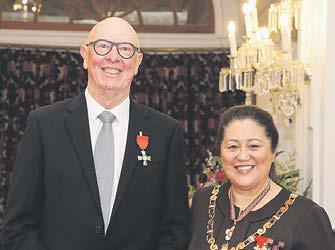




Tompkins Wake Rotorua Business Awards 2025
Venue: Energy Events Centre, Rotorua, Sat 11 October
Photography: Michelle Cutelli Photography
The Tompkins Wake Rotorua Business Awards drew over 780 guests for a spectacular evening of celebration, excellence, and recognition — with many guests remarking it was the best one yet, an unforgettable night that truly showcased Rotorua’s vibrant business community.




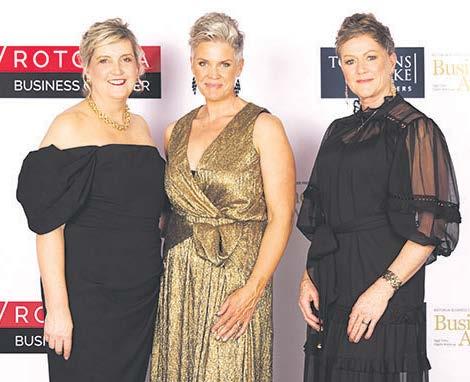







BWN - Networking Lunch featuring MP Hon. Nicola Grigg
October 2, 2025
Photographer: Salina Galvan Photography
Businesswomen from across the Bay of Plenty gathered at Elizabeth Towers for a special networking event featuring Hon. Nicola Grigg, Minister for Women, who shared insights on gender equity and leadership. The event also spotlighted the Ministry’s latest data on gender pay, complemented by local business leaders’ perspectives and a vibrant networking lunch.


